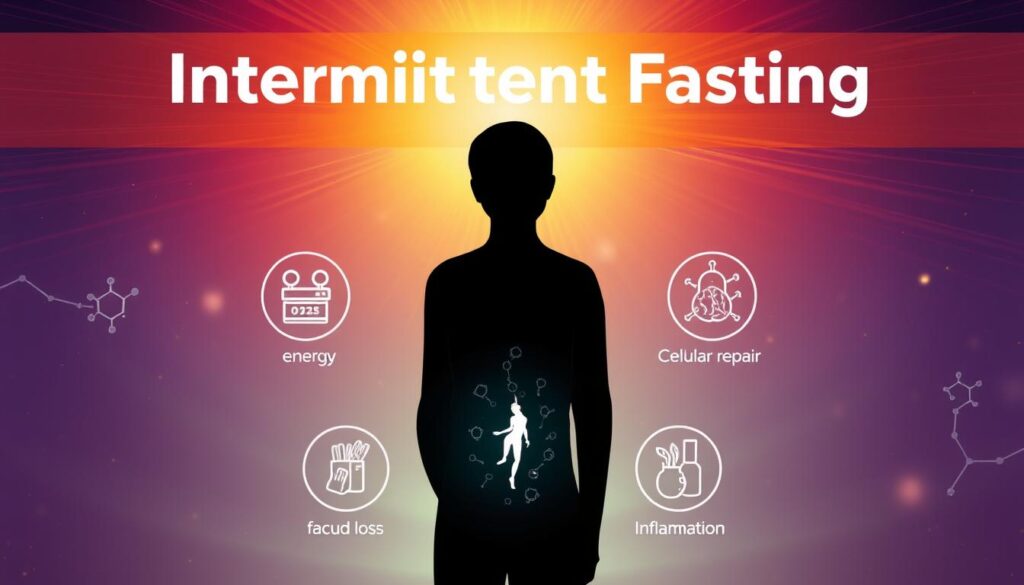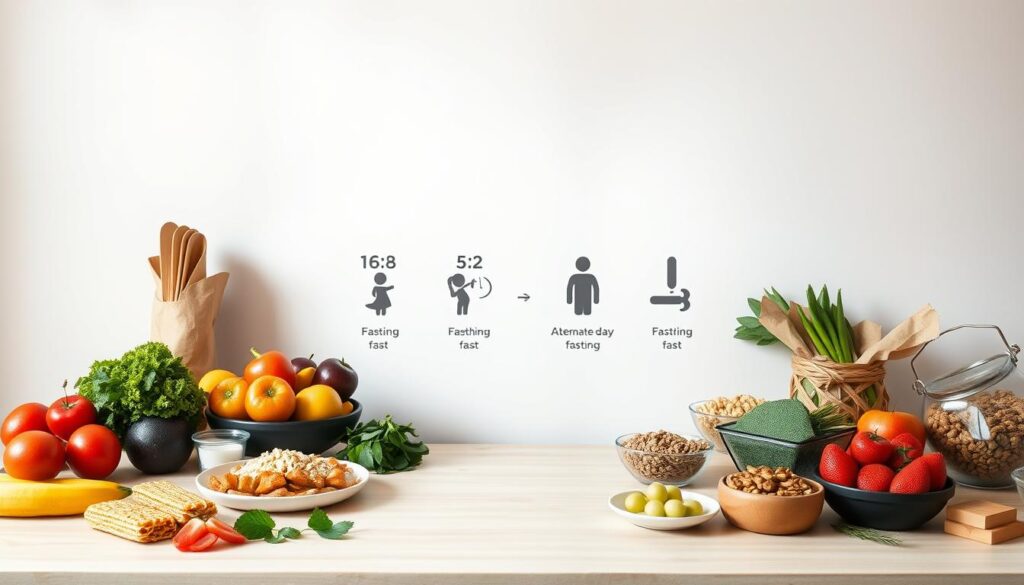Welcome to your friendly guide to intermittent fasting, a popular eating approach that’s gaining attention for its potential health benefits and simplicity. Intermittent fasting involves cycling between periods of fasting and eating, and it’s not about specifying which foods you should eat, but rather when you should eat them.
This guide will explore what intermittent fasting is all about and how it might help with weight management, energy levels, and overall health. By the end of this guide, you’ll have a clear understanding of how to get started with fasting in a way that feels manageable and sustainable for your life.
Key Takeaways
- Understand the basics of intermittent fasting and how it works.
- Discover the potential benefits of intermittent fasting for weight management and overall health.
- Learn about the most beginner-friendly fasting methods.
- Find practical solutions to common concerns and questions that beginners have.
- Get a clear roadmap for getting started with intermittent fasting in a sustainable way.
What Is Intermittent Fasting?
Intermittent fasting has emerged as a flexible and effective way to improve health by cycling between periods of eating and fasting. It’s an eating pattern that involves periods of fasting or calorie restriction followed by periods of unrestricted eating.
The Basic Concept
The basic concept of intermittent fasting involves designating certain hours or days for eating while abstaining from caloric intake during fasting periods. Common methods include fasting for 16 hours and having an 8-hour eating window. This approach allows individuals to eat the foods they enjoy but within specific time frames, making it feel less restrictive for many beginners.
- Alternates between periods of eating and fasting
- Focuses on when you eat rather than what you eat
- Allows for flexibility in food choices within designated eating periods

History and Evolution
Fasting has been practiced throughout human history and across various cultures and religions. Our ancestors naturally experienced periods of fasting when food was scarce, suggesting that our bodies may be well-adapted to handle periods without constant food intake. Modern intermittent fasting has evolved from these historical practices into structured approaches that fit contemporary lifestyles while potentially offering health benefits.
- Historically practiced across cultures and religions
- Adapted to fit modern lifestyles
- Potential health benefits associated with intermittent fasting
The Science Behind Intermittent Fasting
Intermittent fasting triggers various physiological changes that contribute to its health benefits. When you fast, your body undergoes significant changes at the cellular and molecular level, impacting hormone levels, gene expression, and cellular repair processes.
How Your Body Responds to Fasting
During fasting periods, several key changes occur in your body. Human Growth Hormone (HGH) levels increase, which can help with fat loss and muscle growth. Conversely, insulin levels decrease, improving insulin sensitivity and making stored body fat more accessible for energy. Your body’s cells also initiate important repair processes, including autophagy, where cells digest and remove old and dysfunctional proteins.

Metabolic Switching Explained
After several hours of fasting, your body exhausts its glucose stores and begins to burn fat for energy, a process known as metabolic switching. This transition not only aids in weight management but also produces ketones, which can provide fuel for your brain and body. Understanding metabolic switching is crucial to appreciating how intermittent fasting can lead to improved health outcomes beyond just weight loss.
By giving your body regular breaks from digesting food, you allow these beneficial processes to occur, potentially contributing to longevity and disease prevention. This natural process highlights why timing your eating matters and how intermittent fasting works with your body’s natural processes rather than against them.
Popular Intermittent Fasting Methods for Beginners
New to intermittent fasting? There are several beginner-friendly methods to try. Intermittent fasting involves restricting your eating window, and there are various approaches to suit different lifestyles and preferences.
The 12-Hour Fast
The 12-hour fast is a great starting point, where you restrict eating to a 12-hour window each day, such as 7 am to 7 pm. This method is easy to adapt to since much of the fasting occurs during sleep. It’s an ideal approach for beginners, allowing for a consistent calorie intake every day.
The 16:8 Method
For those ready for a slightly more challenging approach, the 16:8 method involves fasting for 16 hours and eating within an 8-hour window. For example, finishing your evening meal by 8 pm and not eating again until noon the next day. This method is also known as the Leangains diet.

The 5:2 Diet
The 5:2 diet offers flexibility by allowing normal eating for five days of the week while reducing calorie intake to about 500-600 calories on two non-consecutive days. This approach appeals to those who prefer having mostly “normal” eating days.
Other Approaches
More advanced methods include Alternate Day Fasting, where you alternate between regular eating days and fasting or very low-calorie days, and the Eat-Stop-Eat approach, which involves one or two 24-hour fasts per week. The Warrior Diet features a 20-hour fasting period with a 4-hour eating window in the evening.
When choosing a method, beginners should consider their lifestyle, schedule, and personal preferences. Starting with the 12-hour fast and gradually extending the fasting window as the body adapts can create a sustainable progression.
Health Benefits of Intermittent Fasting
The health benefits of intermittent fasting are multifaceted, ranging from weight management to improved metabolic health. By incorporating periods of fasting into your lifestyle, you can potentially experience significant improvements in various aspects of your health.
Weight Management
Weight loss is one of the most common reasons people try intermittent fasting. By restricting the times when you can eat, you naturally tend to consume fewer calories. Additionally, intermittent fasting affects hormone levels, aiding in weight loss by lowering insulin, increasing human growth hormone (HGH), and releasing the fat-burning hormone norepinephrine. According to research, intermittent fasting can be a powerful tool for weight loss when done safely, with a 2020 systematic review showing weight loss rates ranging from 0.8% to 13% of participants’ starting weights.
Improved Insulin Sensitivity
Intermittent fasting can reduce insulin resistance, helping your body process glucose more effectively. This can lower your risk of developing type 2 diabetes. By giving your body regular breaks from eating, insulin levels decrease, creating a more balanced metabolic environment. Many people experience improved blood sugar control with intermittent fasting, which is crucial for maintaining overall health.
Other Potential Health Benefits
Beyond weight management and improved insulin sensitivity, intermittent fasting is associated with other potential health benefits. These include reduced inflammation, which is linked to various chronic diseases, and improved brain health, with some studies indicating enhanced cognitive function and potential protection against neurodegenerative diseases.  Heart health markers, such as blood pressure and cholesterol levels, may also improve with consistent intermittent fasting, contributing to overall cardiovascular wellness.
Heart health markers, such as blood pressure and cholesterol levels, may also improve with consistent intermittent fasting, contributing to overall cardiovascular wellness.
Who Should Avoid Intermittent Fasting
Certain individuals should exercise caution or avoid intermittent fasting altogether. While it offers benefits for many people, specific groups should prioritize their health needs and consult with a healthcare professional before starting any fasting regimen.
Medical Conditions
People with certain medical conditions, such as diabetes or blood sugar regulation issues, should consult their doctor before attempting intermittent fasting. Fasting periods can affect blood glucose levels and potentially interact with medications. Those with a history of eating disorders should generally avoid fasting as it may trigger unhealthy relationships with food. Additionally, individuals who are underweight or have nutritional deficiencies should focus on regular, nutrient-dense meals rather than fasting periods that might further compromise their nutritional status.

Special Considerations for Women
Women may need special considerations when practicing intermittent fasting, as some research suggests it can affect hormonal balance and menstrual cycles. According to a 2023 research review, studies have shown that for people who are of average weight, intermittent fasting could harm reproductive health if it causes insufficient calorie intake. Pregnant and breastfeeding women should avoid fasting entirely, as their bodies require consistent nutrition to support their baby’s development and milk production. It’s essential for women to ease into intermittent fasting and stop immediately if they experience any adverse effects on their health or menstruation.
Getting Started with Intermittent Fasting for Beginners
For those new to intermittent fasting, getting started involves understanding the various methods and choosing one that fits your lifestyle. You’ve likely already practiced some form of intermittent fasting without realizing it, such as skipping breakfast after an early dinner and not eating until lunch the next day.
Choosing the Right Method
Selecting the right fasting method is crucial. Many consider the 16/8 method the simplest and most sustainable form of intermittent fasting. You can start with this and adjust as needed. Experimenting with different approaches will help you find what works best for your schedule and lifestyle.
Setting Realistic Expectations
It’s essential to set realistic expectations. According to Mattson’s research, it can take two to four weeks for your body to adjust to the new eating pattern. You might experience hunger or irritability during this period, but many find that they feel better once adjusted.
Creating Your Fasting Schedule
Creating a fasting schedule that works with your life is key. Consider your work hours, social commitments, and family mealtimes when deciding on your eating window. Starting with a 12-hour overnight fast and gradually increasing the duration can make the transition smoother.
As you begin your intermittent fasting journey, remember that flexibility is crucial. Be willing to adjust your approach as needed, and don’t hesitate to seek guidance if you encounter challenges. With patience and persistence, intermittent fasting can become a sustainable part of your lifestyle.
What to Eat During Your Eating Windows
What you eat during your eating windows plays a significant role in determining the effectiveness of intermittent fasting. It’s not just about restricting your eating period, but also about making the most out of the time you have to eat.
During your eating periods, “eating normally” doesn’t mean consuming high-calorie junk food or super-sized fried items. Instead, focus on nutrient-dense foods that provide your body with the necessary vitamins, minerals, and energy.
Nutrient-Dense Foods to Focus On
To maximize the benefits of intermittent fasting, it’s essential to prioritize whole, unprocessed foods like vegetables, fruits, lean proteins, healthy fats, and whole grains. These foods ensure you’re getting adequate nutrition during your compressed eating window.
- Protein-rich foods like eggs, fish, and poultry help preserve muscle mass and increase satiety.
- Healthy fats from sources like avocados, nuts, and olive oil support hormone production and brain health.
- High-fiber foods like vegetables, fruits, and whole grains maintain digestive health and create a feeling of fullness.
Foods to Limit or Avoid
While practicing intermittent fasting, it’s equally important to limit or avoid foods that can spike blood sugar, increase hunger, and reduce the overall benefits. These include highly processed items, sugary foods and beverages, refined carbohydrates, and excessive alcohol.
Being mindful of portion sizes remains crucial, as it’s still possible to consume excess calories even in a shorter eating window. By focusing on nutrient-dense foods and limiting unhealthy choices, you can make the most out of your intermittent fasting regimen.
Staying Hydrated While Fasting
Hydration plays a vital role in the success of your fasting regimen. During intermittent fasting, it’s essential to drink plenty of water and other calorie-free beverages to support bodily functions and manage hunger.
Approved Beverages
Water should be your primary beverage during fasting periods. Aim for at least 8-10 cups daily, increasing this amount if you’re active or in hot weather. Black coffee and unsweetened tea are also acceptable, as they contain negligible calories and may offer appetite-suppressing benefits. Be cautious with additions like cream, sugar, or honey, as they can break your fast.
Electrolyte Balance
Maintaining electrolyte balance is crucial, especially during longer fasting periods. Minerals like sodium, potassium, and magnesium help maintain fluid balance and prevent symptoms like headaches and fatigue. Consider adding a pinch of salt to your water or drinking sugar-free electrolyte beverages to maintain mineral balance without breaking your fast.
Common Challenges and How to Overcome Them
When starting intermittent fasting, people often face several challenges that can be overcome with the right strategies. Understanding these common obstacles can help individuals succeed in their fasting journey.
Managing Hunger
Hunger pangs are a common challenge for people beginning intermittent fasting. To manage hunger, it’s helpful to stay busy, drink plenty of water, and gradually extend fasting periods. Planning distractions on fasting days, such as catching up on paperwork or going to see a movie, can also help avoid thinking about food.
Social Situations and Eating Out
Social situations can be tricky when fasting. Adjusting your eating window for special occasions, choosing restaurants that align with your eating schedule, or focusing on the social aspect rather than the meals can help navigate these challenges.
Maintaining Consistency
Maintaining consistency is crucial for seeing benefits from intermittent fasting. While perfectionism can lead to giving up, remembering that an occasional deviation doesn’t negate overall progress can help. Flexibility is key to sustaining the practice every day.
Conclusion
Intermittent fasting is not a one-size-fits-all solution, but for many, it can be a powerful tool for weight loss and overall wellness. This eating pattern offers a flexible approach to improving health, with various methods to suit different lifestyles.
Research continues to uncover the potential health benefits of intermittent fasting, from improved metabolic health to better cognitive function. However, individual results may vary based on unique physiology and consistency.
The key to successful intermittent fasting is choosing a method that fits your lifestyle and preferences, allowing you to maintain it consistently. If you find that intermittent fasting improves how you feel and fits well with your lifestyle, it can become a sustainable part of your health routine.
